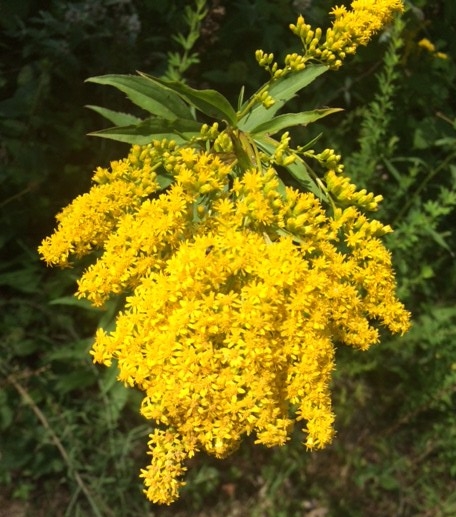
Goldenrod, solidago photo by K. ROberts
Solidago
From the Latin, solido, “to make entire”. Goldenrods, of the Asteraceae, aster family, are a tall standing plant with showy, bright yellow tops. Some species of Goldenrod, which there are 100-120, have been thought to have medicinal benefits, but this has with time turned out to be rumor alone. The Native Americans used the flowers to treat sore throat by chewing on them, Sweet Goldenrod was listed as a stimulant and diaphoretic in the U.S.Pharmacopoeia in the early 1800s, and it has also been crushed and added to lotions to treat bee stings. It is often, ironically, thought to be the culprit of late summer allergies. However, it is often a nearby ragweed causing such a sneeze, since Goldenrod’s pollen is quite sticky and not too quick to travel from anther.
Goldenrods pollen contains a small amount of rubber. This odditiy, theorized by Thomas Edison, could be a ecomnimical source of substance. In modern times, this theory is taking root and being further explored. Goldenrods are thought to be visited and pollinated by more than 100 species of insects, bubblebees, praying mantis and more. The blooms that emerge in mid July and tapper off in early November, lure in all sorts with their bright yellow flowers, (small but quite showy) packed into clusters.
Leaves are arranged alternatively on a three to seven foot stem. This perennial, propagates by root divisin in spring or autmumn and will perform fine in ordinary garden soil. Seeds are dispersed by wind. In the Northeast, it can be found along roadsides, in hayfields, and in dryer woodland areas that get plenty of sunshine. Different species of Goldenrod grow around the world, some in marshes others in desserts. These plants share many characteristics with the sunflower, Helianthus, family which attributes to characterisitcs such as height.
Sources:
Brown, Deni, Encyclopedia of Herbs, 1995
Burn, Barbara, North American Wildflowers, 1984
Adkins, Leonard, Wildflowers of the Appalachian Trail, 1999